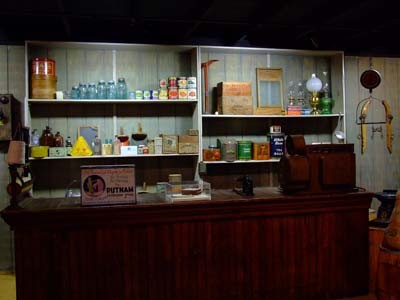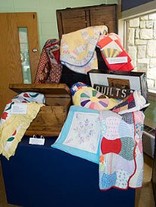Chief Logan Museum
Introduction
Text-to-speech Audio
Images
Chief Logan Museum

One of the museum’s permanent exhibits is The Buffalo Creek Disaster. The worst industrial disaster in the history of Logan County occurred on Saturday, February 26, 1972 when a series of coal waste dams collapsed.

“We are Marshall” Movie Memorabilia. On November 14, 1970, 75 people including most of the Marshall University football team, cheerleaders and coaches and a number of supporters died in a plane crash.

This museum exhibit offers a look at rural general stores in the 19th and early 20th century.

Local quilts on exhibit at the museum.

Backstory and Context
Text-to-speech Audio
Chief Logan Museum is located within the 4,400-acre Chief Logan State Park which features an $8.5 million conference and convention center, as well as a campground, outdoor amphitheater and wildlife center. The Division of Culture and History manages the museum under an agreement with the West Virginia Division of Natural Resources, which operates the park.
The Museum was opened on May 31, 2003, with a ribbon-cutting ceremony hosted by West Virginia Senate President, now Governor, Earl Ray Tomblin. The facility, which is located in the former park restaurant, is operated by the West Virginia Division of Culture and History.The Land, People and Culture of the Southern Coalfields - Stories of the southern coalfields reveal a place rich in natural resources and wealthy in unique individuals. As far back as the prehistoric people and Native Americans that hunted throughout these old mountains, the resilient spirit has prevailed. Pioneers, Confederate sympathizers, industrial magnets, immigrant workers, politicians, community leaders, artists and storytellers – each generation, each community.
Chief Logan Museum is currently hosting an exhibit of local and statewide pieces including quilts and coverlets, sculptures, and paintings. These pieces, both from the West Virginia State Museum Collection and from local artists, depict the rich cultural heritage of West Virginia.
A new exhibit at the museum has opened. Remembering Buffalo Creek, a solemn recollection of the Feb. 26, 1972 tragedy. The exhibit is free and open to the public. Artifacts pertaining directly to the disaster, including the uniform worn by Lila Hinchman, former director of the Logan County Chapter of the American Red Cross, are on display. The Red Cross flag that hung over Man High School following the disaster to mark the school as a shelter and temporary Red Cross headquarters also is featured.
In addition, the exhibit features two films about the disaster, both made by filmmaker and producer Mimi Pickering for Appalshop, Incite Buffalo Creek Flood: An Act of Man (1975, 40 minutes) chronicles the flood which killed 125 people, injured 1,100 and left 4,000 homeless when a coal-waste dam collapsed at the head of a hollow in Logan County. Buffalo Creek Revisited (1984, 31 minutes) was filmed 10 years after the flood and looks at ìthe second disaster on Buffalo Creek,î in which the survivorsí efforts to rebuild the communities shattered by the flood are thwarted.
Other exhibits and activities include:
Dehue...A Special Place: This exhibit created by WVU with help of former Dehue resident Dolores Riggs Davis. The exhibit explores many aspects of coal camp life, from the business of coal mining to the social aspects of living in a community like Dehue.
Looking at Logan: An original exhibit of items from the collection of local Black historian and president of the Aracoma High School Historical Society, Claude Williams. Items include a placard depicting the late Reverend Martin Luther King Jr which has been carried by Mr. Williams at numerous civil rights marches. The reverse of the placard reads "LOGAN W.V."
Ron Moxley Collection: A small selection of Native American artifacts found by the late Ron Moxley, a local archiologist and teacher at Man High School. Items include a nutting stone found in Chief Logan State Park, less than a mile from the museum. Artifacts in this collection are on loan from the Shawnee Trail Associates, Inc.
The museum holds an annual West Virginia Day Celebration on June 17th & 18th that features local reenactors who create an encampment at the museum. The reenactors demonstrate skills and trappings of early West Virginians pre-1880.
